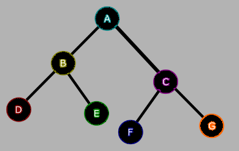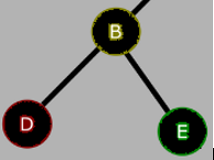Explain post order traversal and find the post order traversal for the following:

The post order traversal is one of the ways to traverse the tree data structure and is used for traversing the nodes in the tree. This traversal follows the principle of Left Right Root which means the left subtree of the root will be traversed first, after that the right subtree, and then, the root node will be traversed.

Here, there are 7 nodes, A as root node and rest 6 as left or right subtree of the root node.
As Post order Traversal works on Left Right Root, the following are the steps by which we can traverse the post order :
A is the root node for the tree, so first of all we will traverse the left subtree which is as follows:

In the left subtree we can say that B is the root node, D is the left subtree and E is the right subtree. So, the post order traversal will be :
D, E, B
Trending nowThis is a popular solution!
Step by stepSolved in 4 steps with 3 images

- The best data structures in terms of asymptotic time complexities for performing the following operations respectively are CONCATENATION (A, B): Concatenate all elements of A and B together Insert(T, key): Insert key to T Delete (T, key): Delete key from T if present Search (T, key): Returns true if key is present in T Stack, Binary Search Tree, Sorted Array, Linked List Linked List, Stack, Binary Search Tree, Sorted Array Linked List, Stack, Sorted Array, Binary Search Tree Stack, Linked List, Sorted Array, Binary Search Treearrow_forwardWrite a program to implement BST (Bindary Search Tree) by using linked list. Implement the following methods: 1) Insert 2)Search 3)The traversal method that gives the output in increasing order. Give name of method and implement the method. Code in C.arrow_forwardNote : Don't Explain .arrow_forward
- Let xHead, yHead and zHead be the head pointers of 3 linked lists of integers (called X-list, Y-list and Z-list, respectively, from here). X-list and Y-list are each sorted (in non-decreasing order) in itself and each may be empty. Z-list is initially empty (i.e., zHead initially contains the null pointer). Develop and test a recursive C++ function called SortedMergeRecur that combines the nodes in X-list and Y-list into Z-list such that, after calling the function, Z-list is a sorted list (in non-decreasing order) containing all the nodes initially contained in X-list and Y-list – X-list and Y-list should both be empty after the call. Other specifications/requirements: ● Each node of the list has the following structure: struct Node{ int data; Node *link;}; ● The function should: ► Have only three parameters (each a pointer-to-Node) and no return value (be a void function). ► Not use any global variables or static local…arrow_forwardQ3 QuickSort Given the QuickSort implementation from class, provide an 18-element list that will take the least number of recursive calls of QuickSort to complete. As a counter-example, here is a list that will cause QuickSort to make the MOST number of recursive calls: public static List input() { return Accaxsaslist(0, 0, 0, 0, 0, 0, 0, 0, 0, 0, 0, 0, 0, 0, 0, 0, 0, 0); } wwwwwww And here's the QuickSort algorithm, for convenience: algorithm QuickSart Input: lists of integers 1st of size N Output: new list with the elements of lat in sorted order if N < 2 return st pivot Jat[N-1] left = new empty list right = new empty list for index = 0, 1, 2, if lst[i]<= pivot left.add(lat[i]) = else N-2 right add(lat[i]) return QuickSort(left) + [pivot] + QuickSort (right)arrow_forwardUSING C++, Implement a TEMPLATED Binary Search Tree (RECURSIVE) class, that is minimal & complete. Provide the following recursive operations: Insert, Delete tree, Search, inOrder traversal, preOrder traversal, postOrder traversal. Methods essential for correct operation of tree in terms of managing memory must be provided. Any additional methods can be added. Use function pointers in the traversal routines. cannot use std::function (or any other similar routine from std namespace. Test BST to make sure all methods work. In particular make sure that you can pass the tree to other routines by value, const reference and reference. Check that data values are as expected on pass/return to/from routines. Do not use GUI interaction. Input/Output (user): Sample output formats shown below use made up data for the year 1905. Menu options are: The average wind speed and sample standard deviation for this wind speed given a specified month and year. (print on screen only) Eg: January…arrow_forward
- Java Programming language Please help me with this. Thanks in advance.arrow_forwardTrue or False? Using an unsorted array to implement a priority queue would allow an O(1) enqueue operation. True Falsarrow_forwardHelp please the function isFull is the only one I need help with it is supposed to return true if the array is full and false if it is not full I Just need to know the code to check if it is full or not help please this is from the study guideC++arrow_forward